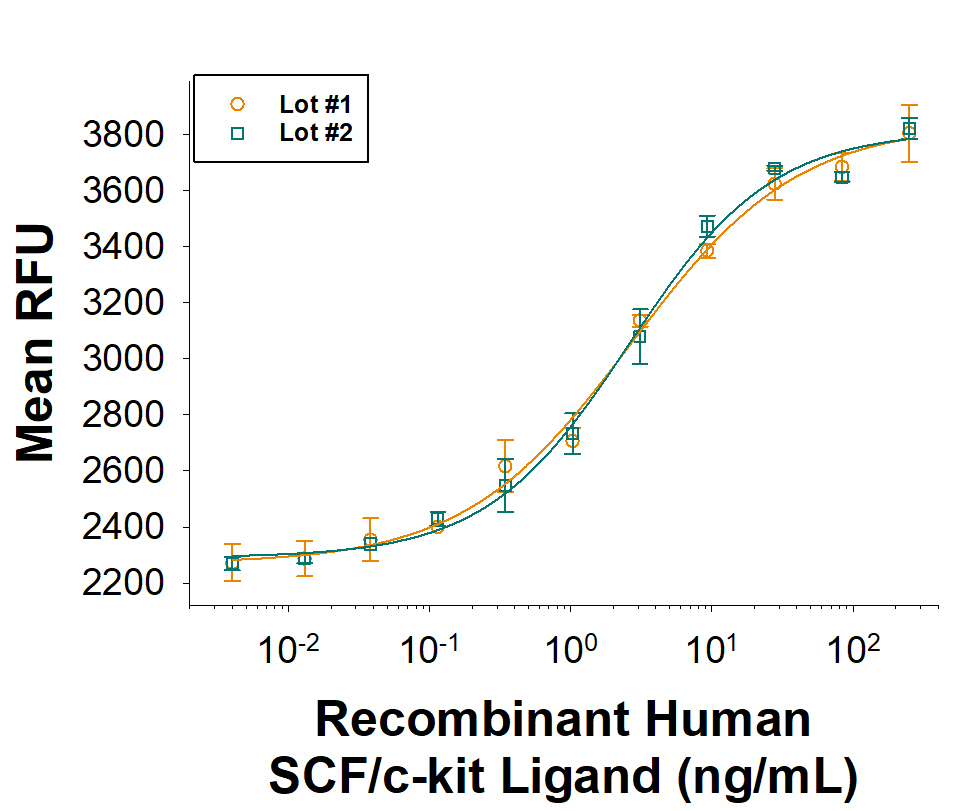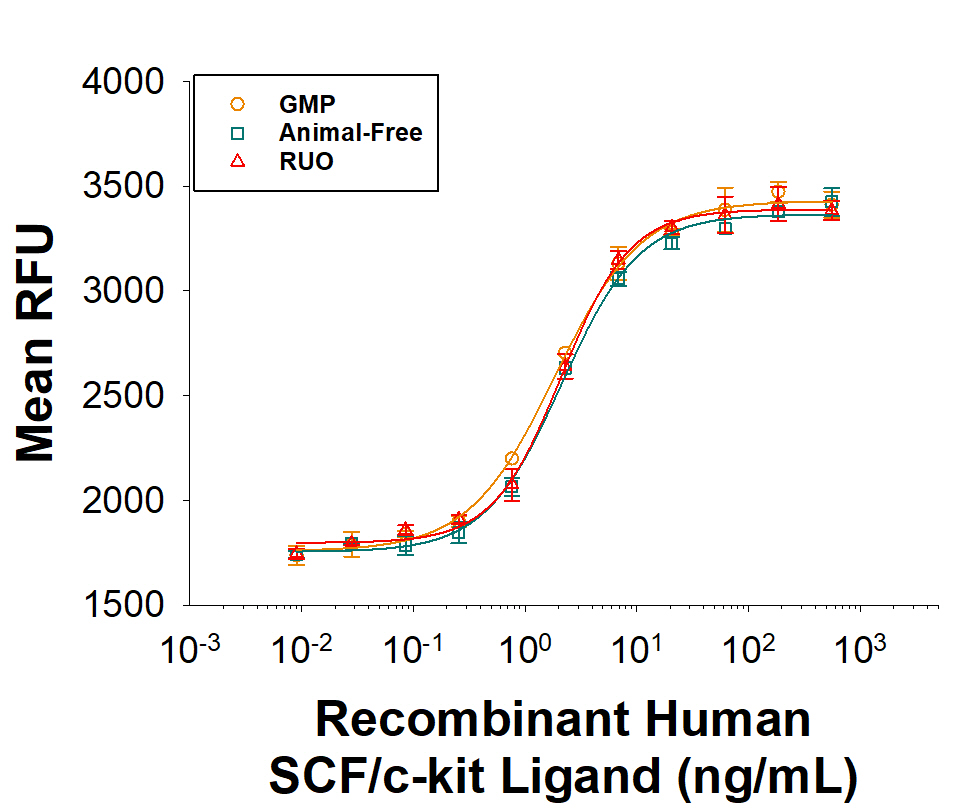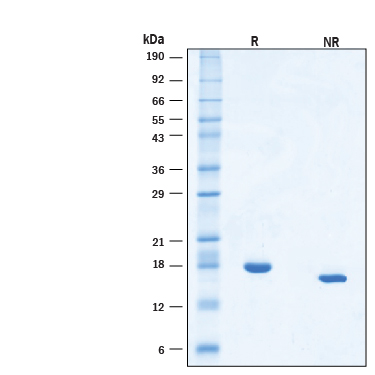Recombinant Human SCF Protein, Animal-Free
Recombinant Human SCF Protein, Animal-Free Summary
Learn more about Animal-Free Recombinant ProteinsProduct Specifications
Glu26-Ala189, with a N-terminal Met.
Produced using non-animal reagents in an animal-free laboratory.
Analysis
Product Datasheets
Carrier Free
CF stands for Carrier Free (CF). We typically add Bovine Serum Albumin (BSA) as a carrier protein to our recombinant proteins. Adding a carrier protein enhances protein stability, increases shelf-life, and allows the recombinant protein to be stored at a more dilute concentration. The carrier free version does not contain BSA.
In general, we advise purchasing the recombinant protein with BSA for use in cell or tissue culture, or as an ELISA standard. In contrast, the carrier free protein is recommended for applications, in which the presence of BSA could interfere.
BT-SCF-AFL
| Formulation | Lyophilized from a 0.2 μm filtered solution in PBS with Trehalose. |
| Reconstitution | Reconstitute at 500 μg/mL in PBS. |
| Shipping | The product is shipped at ambient temperature. Upon receipt, store it immediately at the temperature recommended below. |
| Stability & Storage: | Use a manual defrost freezer and avoid repeated freeze-thaw cycles.
|
Scientific Data
 View Larger
View Larger
Animal-FreeTM Recombinant Human SCF (Catalog # BT-SCF-AFL) as measured in a cell proliferation assay using TF-1 human erythroleukemic cells. The ED50 for this effect is 1.00-8.00 ng/mL.Two independent lots were tested for activity and plotted on the same graph to show lot-to-lot consistency of Animal-Free SCF.
 View Larger
View Larger
Equivalent bioactivity of GMP (BT-SCF-GMP), Animal-Free (Catalog # BT-SCF-AFL) and RUO (BT-SCF) grades of Recombinant Human SCF as measured in a cell proliferation assay using TF-1 human erythroleukemic cells (orange, green, red, respectively).
 View Larger
View Larger
2 μg/lane of Animal-Free™ Recombinant Human SCF/c‑kit Ligand Protein (Catalog # BT-SCF-AFL) was resolved with SDS-PAGE under reducing (R) and non-reducing (NR) conditions and visualized by Coomassie® Blue staining, showing bands at 18 kDa.
Reconstitution Calculator
Background: SCF/c-kit Ligand
Stem cell factor (SCF), also known as c-kit ligand (KL), mast cell growth factor (MGF), and steel factor (SLF), is a widely expressed 28‑40 kDa type I transmembrane glycoprotein (1). It promotes the survival, differentiation, and mobilization of multiple cell types including myeloid, erythroid, megakaryocytic, lymphoid, germ cell, and melanocyte progenitors (1‑7). SCF is a primary growth and activation factor for mast cells and eosinophils (8). Mature human SCF consists of a 189 amino acid (aa) extracellular domain (ECD), a 23 aa transmembrane segment, and a 36 aa cytoplasmic tail (9). The ECD shows both N‑linked and O-linked glycosylation (10). Proteolytic cleavage at two alternate sites in the extracellular juxtamembrane region releases a 25 kDa soluble molecule which is comparable to the only form produced by Steel-dickie mutant mice (11, 12). An alternately spliced isoform of human SCF lacks 28 aa that encompasses the primary proteolytic recognition site (13). Within the ECD of the long isoform (corresponding to this recombinant protein), human SCF shares 79%‑87% aa sequence identity with canine, feline, mouse, and rat SCF. Rat SCF is active on mouse and human cells, but human SCF is only weakly active on mouse cells (9). Noncovalent dimers of transmembrane or soluble SCF interact with the receptor tyrosine kinase SCF R/c‑kit to trigger receptor dimerization and signaling (14).
SCF assists in the recovery of cardiac function following myocardial infarction by increasing the number of cardiomyocytes and vascular channels (15). SCF is a versatile factor in the differentiation of many specific cell types like spermatogonial stem cells (16) and megakaryocyte progenitors (17). Apart from differentiation, SCF also can maintain stemness in cells. This is the case for human bone marrow mesenchymal cells, which require SCF and hepatocyte growth factor for maintenance (18). Hematopoietic stem cells similarly require SCF from surrounding cells in their niche to maintain their stemness and their progenitors (19). SCF has also improved protocols for continuous generation of cells in culture systems, like granulocytes and macrophages (20).
For treatment of graft versus host disease, SCF is used in combination with other cytokines to generate myeloid-derived suppressor cells from human umbilical cord blood (21). SCF is also used to generate T cells for cell-based therapies, drug screening and disease modeling (22). In regenerative studies, SCF is applied in wound healing hydrogel as a means of increasing its adhesion strength and tissue regeneration (23).
- Ashman, L.K. (1999) Int. J. Biochem. Cell Biol. 31:1037.
- Sette, C. et al. (2000) Int. J. Dev. Biol. 44:599.
- Yoshida, H. et al. (2001) J. Invest. Dermatol. Symp. Proc. 6:1.
- Erlandsson, A. et al. (2004) Exp. Cell Res. 301:201.
- Kapur, R. et al. (2002) Blood 100:1287.
- Wang, C.H. et al. (2007) Arterioscler. Thromb. Vasc. Biol. 27:540.
- Bashamboo, A. et al. (2006) J. Cell Sci. 119:3039.
- Reber, L. et al. (2006) Eur. J. Pharmacol. 533:327.
- Martin, F.H. et al. (1990) Cell 63:203.
- Arakawa, T. et al. (1991) J. Biol. Chem. 266:18942.
- Majumdar, M.K. et al. (1994) J. Biol. Chem. 269:1237.
- Brannan, C.I. et al. (1991) Proc. Natl. Acad. Sci. 88:4671.
- Anderson, D.M. et al. (1991) Cell Growth Differ. 2:373.
- Lemmon, M.A. et al. (1997) J. Biol. Chem. 272:6311.
- Kanellakis, P. et al. (2006) Cardiovasc. Res. 70:117.
- Nasimi, M. et al. (2021) Reprod Sci. 28:963.
- Krisch, L. et al. (2021) Int. J. Mol. Sci. 22:8224.
- Cao, Z. et al. (2020) Stem Cell Res Ther. 11:1.
- Comazzetto, S. et al. (2019) Cell Stem Cell. 24:477.
- Bernecker, C. et al. (2019) Stem Cells Dev. 28:1540.
- Park, M.Y. et al. (2019) Front Immunol. 10:1.
- Netsrithong, R. et al. (2020) Stem Cell Res Ther. 11:1.
- Zhang, Li. et al. (2021) Journal Mater Chem B. 29:5887.
Manufacturing Specifications
Animal-Free Manufacturing ConditionsOur dedicated controlled-access animal-free laboratories ensure that at no point in production are the products exposed to potential contamination by animal components or byproducts. Every stage of manufacturing is conducted in compliance with R&D Systems' stringent Standard Operating Procedures (SOPs). Production and purification procedures use equipment and media that are confirmed animal-free.
Production
- All molecular biology procedures use animal-free media and dedicated labware.
- Dedicated fermentors are utilized in committed animal-free areas.
Purification
- Protein purification columns are animal-free.
- Bulk proteins are filtered using animal-free filters.
- Purified proteins are stored in animal-free containers in a dedicated cold storage room.
- Low Endotoxin Level.
- No impairment of biological activity.
- High quality product obtained under stringent conditions.
- For ex vivo research or bioproduction, additional documentation can be provided.
FAQs
No product specific FAQs exist for this product, however you may
View all Proteins and Enzyme FAQsReviews for Recombinant Human SCF Protein, Animal-Free
There are currently no reviews for this product. Be the first to review Recombinant Human SCF Protein, Animal-Free and earn rewards!
Have you used Recombinant Human SCF Protein, Animal-Free?
Submit a review and receive an Amazon gift card.
$25/€18/£15/$25CAN/¥75 Yuan/¥2500 Yen for a review with an image
$10/€7/£6/$10 CAD/¥70 Yuan/¥1110 Yen for a review without an image


